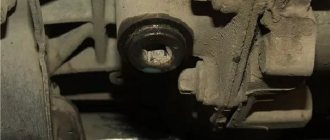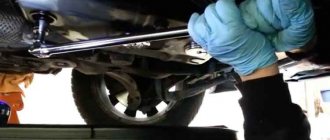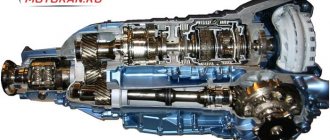The need to flush the manual transmission: how to flush the box, when and why
Let's start with the fact that usually a complete oil change in the box is carried out approximately every 60-70 thousand kilometers (the oil can be changed either independently or at a station). Also, before changing the oil, if necessary, the manual transmission is washed.
Maintenance of any car includes a number of routine maintenance, including checking the oil in the box. The quality and level of oil in the manual transmission must comply with the technical standards of the manufacturer. In practice, there are often cases when an oil change is carried out a little earlier than the scheduled maintenance.
For example:
- inability or difficulty shifting gears;
- shifting gears, accompanied by extraneous sounds (grinding, noise, etc.);
- discrepancy between the selected gear and the speed limit of the vehicle, etc.
At the same time, do not forget that the lubricating fluid is subject to aging, as a result of which the oil loses its properties and ceases to perform its functions. For this reason it is very important
changing gearbox oil
carry out on time. Usually, before changing the oil, the box is washed with special means, since a complete replacement may not completely remove all contaminants from the manual transmission.
Flushing the manual transmission when changing the oil helps:
- softening and removal of various deposits, wear products, etc.;
- cleaning oil channels, improving the circulation of oil fluid;
- complete removal of old oil;
- extending the service life of oil seals and rubber seals.
How to change the oil in a manual transmission (manual transmission)
› Transmission
After purchasing a car, the driver gains comfort, as well as some responsibilities. In order for the car to function properly and not break down for a long time, the car owner must maintain it according to the factory recommendations. It is clear that an automatic transmission must be filled with lubricant, but not everyone knows whether an oil change is necessary in a manual transmission. This topic has many questions, especially for novice drivers. In the review we will find out what kind of oil is poured into a manual transmission, the need and frequency of this procedure, and we will give step-by-step instructions for replacement.
Why change the oil in a manual transmission?
In an automatic transmission, a special lubricating fluid plays the role of a working body. It transmits torque to the chassis from the engine using a hydraulic transformer. A manual transmission does not have a torque converter or oil pump. But it needs oil.
Lubrication in manual transmission solves the following problems:
- Lubrication of parts. The gears of the mechanism are in constant contact with each other. If there is lubrication, the engagement occurs smoothly, which means that parts do not wear out so quickly due to reduced friction.
- Removal of wear products from parts.
- Protection. The lubricant creates a protective film that prevents the formation of corrosion and protects against friction and oxidation. This increases the service life of the unit.
- Heat removal. When the car is driving, the temperature of the lubricant in the gearbox can reach up to 150 degrees. Where the gear teeth touch, the temperature is even higher. Therefore, the oil cools such places.
Even a small amount of oil in a manual transmission can significantly increase its service life. Many manufacturers of units claim that the oil in their unit does not need to be changed until the end of the machine’s operation. But no one anywhere indicates how long a car should last. Even if you buy a new car at the dealership, the managers will not answer you, or they will prove that your grandchildren will still drive it.
According to American and European standards, a car must be scrapped after 7 years, provided that the mileage was more than 35,000 km each year. But such standards are not suitable for a Russian, because for him this is practically a new car. Therefore, the standards for the operating time of cars in different countries are much different.
Reasons for changing the lubricant in a manual transmission
Let's list the main reasons for changing the oil in a manual transmission:
- On many modern machines, the gears are made of high-strength material, but wear still occurs. After some time, the lubricant becomes saturated with wear particles. And in a manual transmission there is no filter element for oil, so wear products are always found in it. Is that sometimes they install magnets that attract metal dust. Over time, wear increases.
- Oil gradually reduces lubrication effectiveness. Of course it will take a lot of mileage, but eventually it will turn dark and contain a lot of steel filings.
- During operation with high heat and friction, the oil begins to foam. And this does not allow it to perform lubricating, cooling and protective functions. As a result, gears and other parts may break. To prevent this from happening, special additives are used, which also gradually become unusable.
- When severe wear occurs, the driver will hear noise from the manual transmission, which is especially noticeable when changing gears. In this case, you need to take measures to repair and change the oil.
- After this, the work becomes smooth, soft, and no knocks are heard.
The oil requires mandatory replacement, and the frequency of this procedure and the procedure will be discussed in the following sections.
How often does it need replacement?
When manufacturing automobiles, the manufacturer specifies maintenance requirements for each brand. This information can be found in the machine manual. It indicates the period for replacing the lubricant in the box.
Today, you can find technical documentation for any car model on the World Wide Web. It defines the exact mileage or time period at which you need to change the oil in the manual transmission. But there are average values for any car when it is necessary to change the lubricant according to the regulations. In terms of time, this should be done every 5 years or 100 thousand km.
Often, for Russian cars produced before 2000, according to documents, the oil change period is specified after a mileage of 200 thousand km. But modern cars of Russian or foreign manufacture have the same recommendations for their entire service life. This means that the car must be disposed of after the expiration date. But no one does this; they try to sell her. Therefore, in order for the car to continue to drive, the lubricant in the gearbox needs to be changed more often.
Generally accepted recommendations are every 80,000 km or every 5 years. If operating conditions are severe - after 50,000 km.
Sometimes you have to change the lubricant deviating from the regulations. This is done in the following cases:
- Buying a car. Replacement is necessary because there is no guarantee that maintenance was carried out on time.
- Replacing the manual transmission. It is better to fill the new unit with fresh oil. But, if in the old unit it was changed according to the regulations, then in the new one the lubricant can be reused.
- Box repair. After overhauling the unit, only fresh lubricant is used.
- Noise or jerking when changing gears. To eliminate these causes, you can first change the oil and then try to repair it.
Causes of manual transmission contamination
The most common reason for contamination and the need to flush the gearbox is water getting into the mechanism. The manual transmission is leaking. It must be in contact with the atmosphere to avoid the formation of excess pressure or vacuum due to temperature changes.
The valve, which provides air inflow or outflow (breather), is located at the top of the box. Under normal operating conditions, it works normally, but if the car gets into a deep puddle, water enters the breather. The box cools sharply, and the transmission oil turns into an emulsion. If such a liquid is not replaced in time, the process of hydrolysis begins, that is, “saponification” of the oil. At the same time, it loses all its lubricating and cleaning properties.
Transmission fluid can also cause contamination of the manual transmission if it overheats for a long time. This occurs when driving for a long time at high speed or in off-road conditions, or when towing a heavy load. Due to unacceptably high temperatures, the oil in the box begins to “cook”, forming something like an ointment.
Deposits in the manual transmission oil pan, as well as on other parts of the unit, are caused by oxidized oil if oil change intervals are not observed.
Flushing the automatic transmission during a partial oil change
So, during a partial oil change, the liquid is drained from the box through the neck, then the automatic transmission sump is removed, from which some of the oil is also drained. That's all. At the same time, a decent portion of it still remains in different places in the box. Then the whole thing is returned to its place, and fresh oil is pumped into the box. This is how a partial oil change in an automatic transmission occurs - the new oil is mixed with the remainder of the old oil
, hidden in the mechanisms of the box.
Operating principle of flushing oils
Table for assessing the degree of contamination of engine parts.
Before changing the gearbox oil, let the engine run for a while. The heated grease will drain faster and better. After draining the old fluid, fill in the flushing fluid in exactly the same volume as the working fluid. Let the engine idle again. In about 20 minutes, the washing liquid should have time to rinse the entire box. The used flushing oil must be drained and replaced with working oil.
Do I need to use a flush? Flushes are practically not used abroad, so you won’t see flushes from Castrol or Shell on store shelves. Such manufacturers claim that if all maintenance standards are observed, there is no work to be done for flushing. But this statement is true subject to a number of conditions:
- The car must be new, from the showroom.
- The quality of the fuel must be impeccable.
- The oil is changed frequently and the transmission is serviced regularly.
These conditions are not always feasible for our country. Cars are not always purchased from a dealership, and recommended regulations are almost never followed. It is for such cases that flushing comes in handy.
Innovation in the market. Quite recently, a new product appeared on domestic shelves - LAVR. This tool opens up completely new perspectives in car maintenance. Usually no one really thinks about why the checkpoint is not usually cleaned of contamination?
Benefits of LAUREL oil.
Gearboxes and axles are also often left without proper attention. If you think about it, these components bear no less load than an engine in which the oil is changed regularly.
The reason lies in the fact that car manufacturers consider these components to be maintenance-free. LAVR became the first domestic product for cleaning gearboxes, drive axles and transfer mechanisms of both cars and trucks. This product is indicated for use at every oil change in these units. The manufacturer guarantees the following results:
- Absence of wear products during operation in gearboxes and other components.
- Increased service life of units where flushing is used.
- Restoring the plasticity of rubber seals.
- The use of reducing and antifriction additives significantly enhances the effect of using LAVR.
Do I need to flush the engine before changing the oil?
The need to flush the engine from old oil and contaminants arises for the following reasons:
- when changing the oil,
- when oils of several types and brands were mixed,
- when the replacement interval has been exceeded.
The reason for flushing may be overheating of the power unit. Under conditions of constant use, the oil loses its beneficial qualities ahead of schedule, which is why it is recommended to flush the engine before the next scheduled replacement.
What is the difference between engine flushes and flushing mixture?
The oil contains detergent additives that help clean the engine from dirt and deposits.
There are the following types of washing mixtures :
- ready-made washing mixture;
- additives for mining;
- "five minutes";
The first group is almost never used. The principle of operation is as follows: the liquid from the power unit is drained, a flushing mixture is poured in, on which the car continues to operate for some time in a gentle mode.
The advantage of this flushing is that thoroughly cleaned of dirt.
Flushing the engine when changing the oil takes approximately two days , during which the alkali comes into contact with the seals. They wear out, which leads to their replacement.
The second group - additives appeared later. The products presented are in the form of additives to the existing mixture with a volume of about 300-350 ml , or as a ready-made rinse in 4 and 5 liter . Using the specified flush, regardless of its type, involves running the engine at idle speed for 15 minutes . Next, the old mixture is drained, after which you need to fill in the new one.
The emergence of “ five-minute washes ,” as car owners call them, implied quick cleaning of dirt from the engine. It is surprising that previously the dirt was washed off under heavy loads on the engine within two days, but the composition of the new mixture removes the dirt in 10-15 minutes. at idle speed.
Procedure for using LAUR
- The flush is poured directly into the old oil through the filler hole in the amount of 100 ml of flush per 1 liter of oil.
- Using a lift or jacks, the driving wheels of the car are suspended in the air.
- The engine starts, then you need to switch gears in random order within 10 minutes.
- After completing this procedure, the old oil with flushing should be drained, and new oil should be poured in its place.
Purpose. This innovative product works on a completely new principle.
How to flush the gearbox before adding new oil?
Before changing the oil, to ensure greater fuel fluidity, it is necessary to warm up the manual transmission. Next, you should park the car on a flat surface, for example, on an overpass. After this, you can begin the procedure for replacing and flushing the mechanics.
The main stages of manual transmission flushing:
- Access to the box opens.
- An empty container is installed under the gearbox where the fluid will drain. The container volume depends on the amount of fuel used in the box.
- The filler plug is loosened.
- The drain plug is unscrewed.
- The drain plug must be cleaned.
- As soon as the liquid is drained, the cap is screwed on.
- Flushing oil is added through the filler hole in exactly the same amount as the volume the manual transmission is designed for.
- It is necessary to let the engine idle for about 15 minutes.
- Next, the flushing fluid is drained and new fuel is added.
In this case, you should stock up on rags, a set of keys, screwdrivers, and a funnel with a hose.
What is manual transmission flushing oil?
Traditional flushing oil, both for internal combustion engines and gearboxes, is an inexpensive mineral oil with the addition of detergents and various additives that prevent wear of gearbox elements. As a rule, zinc and phosphorus are used as additives, and calcium as detergents.
The flushing liquid (oil) not only washes away the remnants of old used oil, but also neutralizes the acidic environment formed since the last oil change.
If the contamination is serious enough, the box is disassembled to eliminate it (each individual element is mechanically cleaned and washed).
Flushing the gearbox: when is it necessary and how to flush the gearbox
As you know, the gearbox, regardless of the type of gearbox (manual, robot, automatic), needs regular maintenance. Such maintenance should mean replacing the transmission oil in the unit, as well as the gearbox oil filters. In this case, you can often find that the drained “working” is heavily contaminated; fresh oil can also quickly become contaminated after replacement, etc.
In the case of an automatic transmission, it also happens that the decision to change the oil is dictated by the appearance of jerks and jerks in the automatic transmission when changing gears. However, changing the oil does not help solve the problem.
The oil is also changed when switching to another type of lubricant to avoid mixing transmission oils. In any case, in such situations it is recommended to additionally flush the gearbox before changing the oil. Next, we will look at how to flush a manual or automatic transmission, as well as how to flush the gearbox.
Flushing the gearbox when changing the oil
So, as in the case of the engine, it is optimal to use gearbox flushing oil to flush the gearbox. Gearbox flushing oil allows you not only to remove waste residues from the unit, but also to wash hard-to-reach areas and hidden cavities, remove stubborn dirt, etc.
It is important to understand that usually flushing oil consists of a mineral base with the addition of active detergent additives and anti-wear components (zinc and phosphorus protect against wear, calcium acts as a detergent).
The flushing itself is necessary to neutralize the acidic environment in the unit, remove waste residues and persistent contaminants, etc. At the same time, it will still not be possible to get rid of severe contamination, since disassembly of the gearbox and mechanical cleaning are necessary.
To understand when to use flushing, you need to consider a number of factors and features:
- general condition of the unit;
- regularity and quality of checkpoint service;
- quality of gear oil used;
- possible malfunctions and ingress of technical fluids into the unit (for example, antifreeze in the gearbox).
As a rule, if the unit is not very worn, the gearbox is working properly, and the oil is used of the same brand/type and is changed regularly, you can refuse flushing. If these conditions are not met, it is better to wash the gearbox. In this case, you should wash the manual transmission or automatic transmission, separately taking into account all the manufacturer's recommendations for washing.
How to use LAVR
How to wash the transmission with your own hands? This is easy to do if you use LAUREL.
- The flushing liquid is poured into the used motor oil through the oil filler neck (one hundred milliliters of product per liter of oil product).
- By means of an overpass or jacks, the front wheels of the car are raised above the ground.
- The engine starts, transmission modes change randomly for ten minutes.
- Upon completion of washing, the used oil product and the washing agent are drained, and fresh motor oil is poured in.
Transmission maintenance is not included in the car service regulations. If the car was purchased secondhand, there is no guarantee that all necessary procedures were carried out on time and correctly. Any service center will tell you that gearbox lubricant changes its color and consistency during operation. This is due to oxidation and accumulation of wear products. These changes affect the functioning of the transmission.
Do not mix different motor oils
Products from different manufacturers are not unified; there are many differences: first of all, different base oils and different additive packages, which may be incompatible with each other.
When mixing different oils, follow these rules:
- Oils must match the viscosity class - SAE. Read more in one of our previous articles: there we deciphered and explained the meanings of the main classifications of motor oils.
- Oils with a higher API classification can be added to oils with a lower performance class, but not vice versa.
- It is preferable to mix oils from the same manufacturer.
Let us clarify once again: mixing different motor oils is subject to a complete oil change in the near future.
Manual transmission flushing: what is it for and when is it necessary?
A car is a complex unit consisting of many components, elements and parts. One of these components is a manual transmission, the correct operation of which requires not only compliance with operating rules, but also timely and high-quality maintenance.
Maintenance of a manual transmission consists of checking the oil level in the box, partial or complete oil change, flushing the manual transmission (if necessary), timely repairs, adjustments, etc. Next, we will look at when and why you need to flush the manual transmission before changing the oil.
Read in this article
Complete automatic transmission cleaning
Often new car owners are interested in how to flush an automatic transmission at home. For a complete flush, you will need to disassemble the machine down to spare parts. If the car owner does not have certain skills, then it is recommended to use the washing method described above or take the car to a service station.
Read
How to check an automatic transmission torque converter: main symptoms of a malfunction
Pallet
To start flushing, you need to drain all lubricant from the automatic transmission. And then start disassembling the machine.
The procedure is performed like this:
- The automatic transmission warms up by running the car. You can drive a vehicle for about 5 kilometers to warm up the machine to 70 degrees.
- Drive onto the overpass. Or it is best to lift the car on a lift. This is how the box and components will be dismantled.
- Unscrew the drain plug and place the container. Drain off all liquid.
- Unscrew the bolts of the box pan.
- Carefully remove it. Since there may be residual oil in it, drain it.
- Wash the pan with WD 40 liquid.
- Remove the magnets and clean them of metal shavings.
Remove the old filter device. Now you can start flushing the valve body.
Flushing the automatic transmission valve body
To wash the automatic transmission with your own hands, as experienced mechanics do, you need to dismantle the hydraulic plate.
Dismantling steps:
- After completing the first procedure, begin removing the valve body.
- Disconnect the connector and remove the adapter.
- Carefully remove the hydraulic plate from the machine so that no dirt or dust gets into it.
- Remove the electronic board and unscrew the bolts.
- Remove the top of the device.
- Unscrew the other plates. Carefully remove, not forgetting the springs.
- Remove the rods and place them on the table in the order in which they were removed.
- Use ABRO CARB Cleaner for cleaning.
- Replace all failed solenoids.
- Reassemble in reverse order.
Read
DIY Renault Megane automatic transmission repair
Leave to dry on the table and move on to the filter device.
Washing the automatic transmission filter
Experts recommend replacing the box filter after 70,000 kilometers. However, if the car owner started flushing the automatic transmission before driving the required amount of kilometers, then he can wash the filter device and not install a new one. Use WD40 to wash the filter.
Flushing the automatic transmission torque converter
After the hydraulic unit has been removed, you need to completely dismantle the box. It should be noted that its weight starts from 65 kg. It all depends on the configuration. Therefore, it is advisable to carry out all work with a partner and having special lifts in the garage.
After the machine is removed, it is necessary to disassemble it.
- Remove and cut the donut.
- Check the turbine blades and pump wheel for deformation and wash them with Abro Cleaner liquid. Allow time to dry.
- Replace seals and seals.
- Carefully and tightly weld the seam connecting the two sides of the gas turbine engine.
After this, you can begin flushing the radiator, installing components back and changing the oil.
Flushing the transmission radiator
After all components have been washed and individual used automatic transmission parts have been replaced, you need to start cleaning the cooling system. It plays the main role and prevents the entire automatic transmission from overheating.
Many car owners recommend using kerosene to flush the radiator. But usually such a procedure is fraught with problems, which will be discussed in the next block.
To flush the radiator, you need to take a circular pump, oil and drive the lubricating fluid through the pipes of the cooling system.
After drying all the components, reassemble the automatic transmission in the reverse order and install it on the car. Fill with new oil. Drive ten kilometers and measure the level. If necessary, top up.
Read
Removing, washing and repairing the valve body of an automatic transmission 5hp19
Instructions for changing the oil in a manual transmission yourself
If a person is not a very experienced driver and he has a vehicle with a manual transmission, then he often has a lot of questions about servicing his “iron horse”. One of these questions will be the following: rules for changing oil in a manual transmission.
In this article we will consider all issues related to this topic.
Why is oil poured into the “mechanics”?
If everything is completely clear with an automatic transmission, the oil or transmission fluid is an integral component of the automatic transmission, which transmits torque. In this regard, it is very important to monitor the timely change of fluid in the automatic machine. But even in mechanics, oil plays several important functions:
- Lubrication function. A manual transmission has many moving metal parts. The gears constantly interact with each other during operation, and their natural wear occurs. The presence of transmission fluid makes this process more gentle - it significantly reduces friction.
- Protection function. By covering all parts, the oil forms a protection that preserves them from oxidation and corrosion.
- Wear removal function. With constant friction, wear products are formed on parts, which in turn create the preconditions for increased friction and increased wear of parts. It is the transmission lubricant, washing the gears, that removes these small metal chips.
- Temperature reduction function. After just a short trip, the oil temperature in the manual transmission rises to approximately 150 degrees. The temperature in the places where the gears engage is much higher at the same time. Thus, by washing these gears, the transmission fluid provides partial cooling of the parts.
Based on these functions, it can be understood that oil in “mechanics” is a very important element.
Is it necessary to change the oil?
Understanding the importance of transmission fluid in a manual transmission for a car, the question arises: is it necessary to change the oil in a manual transmission and how often. Many gearbox manufacturers add confusion to this issue, claiming that their products do not require maintenance, and oil is filled in for the entire service life of the vehicle. This is not entirely true.
Changing the oil through the manual transmission filler plug
Transmission manufacturers do not indicate anywhere how long the unit’s operation can be expected by the vehicle owner. But the vehicle can be used for a very, very long time. The approach to the age of a car is different between the manufacturer and our consumer, to put it mildly.
If both the manufacturer and the owner of a car in Europe believe that when a car has a mileage of 35,000 km every seven years, then it is only suitable for scrap metal, in our country it is practically a new car. Taking this into account, we can assume what resource most car consumables are designed for.
Here you can give clear advice:
It is advisable to change the oil in a manual transmission after a mileage of 100,000 km. or after 7 years of operation. If the conditions under which the car was used were very difficult, then replacement work can be carried out much earlier.
Signs of deteriorating transmission fluid quality:
- All parts are subject to wear, gears in the gearbox are no exception. Since the “mechanics” do not provide for the installation of filters, all wear products remain in the manual transmission permanently. In this case, the liquid darkens very much and has inclusions of shavings and metal chips.
- After 150 -250 km. mileage, the lubricant most often simply loses its properties.
- Constantly high temperatures cause the old oil to begin to foam and also lose its lubricating properties.
- If strange noises appear in the box, then this is a clear signal about wear of parts and work on repairing and replacing the transmission fluid can no longer be postponed.
How much oil is needed for a complete change?
The volume of transmission fluid poured into the manual transmission is very small, approximately 3.5 liters. More accurate information on the quantity and volume of lubricant in a manual transmission can be found in the technical characteristics of each specific car model. Considering this fact, it becomes clear that the replacement will not hit the car owner’s wallet too much, especially if you do everything yourself.
Draining the oil from the gearbox
Today, manufacturers offer a wide variety of transmission oils - mineral, semi-synthetic and synthetic. Depending on what kind of transmission fluid is used, the rules for changing the oil in the manual transmission will largely depend. So mineral fluids are changed every 35,000 - 40,000 km, semi-synthetic - 45,000-50,000 km, synthetic - 65,000-70,000 km.
Do-it-yourself oil change
If you have already decided to change the oil, regardless of the reason, then it is best to plan the work for the autumn period. In winter, the entire car will be subject to the heaviest load and everything must be ready for such functioning. Transmission fluid must be replaced if the car was purchased second-hand. After all, no one can guarantee that the seller told everything honestly.
What you need to prepare
For ease of use, you need to prepare in advance:
- A container into which the waste liquid will be drained.
- Funnel.
- A syringe or thin hose about half a meter long.
- Rags.
- Transmission fluid.
- Keys.
Location of the gearbox drain plug
Step-by-step replacement algorithm
- We warm up the oil in the manual transmission; for this you need to drive about ten kilometers. This procedure will greatly facilitate the process of complete draining.
- We put the car in the pit and fix it well.
- We thoroughly clean the hole for filling the transmission fluid with a rag.
- If there is a dipstick for monitoring the liquid level, it must be removed.
- First, unscrew the cap on the filler neck and only then unscrew the plug on the drain hole using a wrench. You need to be careful here - the oil will be hot and you can get seriously burned. The liquid must be drained into a special container prepared in advance. Its volume should be slightly larger than the declared volume of fluid in the manual transmission.
- Let the oil drain completely.
- Check the condition of the cover and gasket. If the lid is in good condition, then after clearing its magnetic part from metal shavings, screw it tightly into its original place. It is best to replace the gasket immediately.
- We insert a funnel and a thin hose into the oil filling hole or use a syringe and pour the required amount of lubricant into the manual gearbox.
- It is necessary to check the transmission fluid level; it should not exceed the MAX level.
- Use a rag to remove all lubricant leaks from the manual transmission housing, otherwise this is where dirt will begin to accumulate.
Depending on the make of the car, the process we described “how to change the oil in a manual transmission” may vary slightly.
For example, it may be necessary to dismantle the vehicle protection or remove and wash the pan, replace the filter and sealing ring, but the basic principles of this work remain approximately the same for all brands of cars.
What you need to prepare for washing the automatic transmission
Automatic transmission washing, even at home, should be carried out at a professional level. This means that you need to prepare all the tools and materials so that you don’t have to run around looking for them later.
To flush the automatic transmission you will need the following materials and tools:
- container for draining waste liquid;
- lint-free cloth;
- wrenches, sockets and ratchets. It is advisable to have these tools included;
- an overpass or a small hill to crawl under the car;
- flushing oil to clean the automatic transmission from dirt;
- oil that will be poured into an already clean unit.
All these tools must be prepared and left in the garage or the place where self-disassembly and washing will take place. After this, you need to get behind the wheel to begin the procedure.
Attention! Vehicle service centers use special washing units with high-pressure units. Therefore, the car owner decides to wash the machine himself or use the services of a service station.
Flushing the gearbox on all VAZ cars
Welcome! Flushing the box - many people already know that it is necessary to flush the engine after any defective oil, because if it is not washed, then the defective oil (a fake, one might say) will remain on the walls of the engine and will gradually begin to destroy it, but Few people know that the situation is exactly the same with the gearbox, so when filling in fake oil or if you mixed any oils (This cannot be done, only as a last resort), flushing the gearbox is mandatory and must be done.
Note! To flush, you will only need to buy: Firstly, the flushing oil itself for the box, as well as a special syringe with which you will pour oil into the box (If there is no syringe, then in this case you can make a special thing from improvised means, thanks to which it will also be possible to pour oil into the box, we will tell you how to do this a little lower in the article which you will follow the link) and you will also need to stock up on wrenches and spanners, and in addition, buy a wide container that will hold 5 liters !
Where is the gearbox? On all front-wheel drive cars that are produced by VAZ, the gearbox is located in the same place, namely it is installed at the end of the car’s engine, so if we take into account the fact that the engine is located transversely and not longitudinally as on the classics, then accordingly and the box will be located on the side and at the very bottom, so that you can better understand its location, then in this case, look just below the photo in which it is indicated by an arrow under the number 3.
Note! Now, as for the classics, for many people the location of the gearbox on classic cars does not cause any difficulties at all and people immediately point their finger at it, but not all people unfortunately know this, so for these people we explain that the gearbox is located on classic cars immediately under the gear shift lever, which is located in the cabin (you can navigate by it), so that you can clearly understand its location, see the photo below, it is indicated by an arrow on it!
When should you wash the box? As mentioned earlier, due to low-quality burnt oil, it is necessary to flush the box, because it can lead to the formation of corrosion, which in turn can have a very serious impact on the box; in addition, washing must be done if you mixed oils of two different brands and with different additives ( In this case, a very unpleasant mixture of additives occurs, which will also damage the gearbox), and you also need to do washing if, after you drained the used oil from the unit, it turned black and metal shavings were found in it, these shavings fly from the gears of the gears, they can fly due to improper operation of the box (sharp engagement and gear shifting at high speeds) or due to the fact that there was practically no oil in the unit when you operated the car, in this case, thanks to flushing all the remaining parts of the oil with metal shavings on the walls of the box will merge into a container and after that you can fill in normal oil, and you can be sure that these chips have been removed from the unit.
How to flush the gearbox on all VAZ cars?
Note! We would like to immediately note that the flushing instructions are tailored for front-wheel drive cars; in principle, everything is the same with rear-wheel drive cars, they just have the box in a slightly different place and pouring flushing oil into it will be much more convenient than on front-wheel drive!
1) Flushing is done as follows, firstly, if you have a front-wheel drive car, then study the article on changing the oil in it, this article is called: “Changing the oil in the box on a VAZ 2110” (Do not pay special attention to the make of the car, since the box that on the Priora, that on 2114, that on the Grant and that on other cars it was installed very similar to each other), but if you have a rear-wheel drive car, then everything is a little different here, about how to change the oil in it, read the article: “ Changing the oil in a box on a VAZ”, these articles describe everything in detail.
2) After studying the articles you need, you may have a question: “Why study them at all?” The whole point is that flushing the box is carried out by changing the oil, that is, you will need to drain the old oil of their unit and then not new, but pour flushing oil into it, and after the flushing oil is poured into the box, you will need to hang one of any parts of the car (For example, you can lift the left wheel with a jack so that it hangs in the air) and then start the engine of the car, when the engine starts, engage first gear and let it run for 5-7 minutes, after this time has passed, turn off the engine and drain all the flushing oil from the box and fill it with normal oil and you can consider that you are flushing the gearbox carried out.










